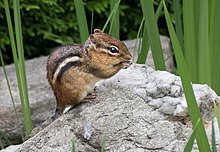Chipmunk
A chipmunk is a small squirrel-like rodent. It is in the Sciuridae family. About twenty-three species fall under this title, with one species in North America.
| Chipmunk Temporal range: Early Miocene to Recent
| |
|---|---|

| |
| Eastern chipmunk (Tamias striatus) | |
| Scientific classification | |
| Domain: | Eukaryota |
| Kingdom: | Animalia |
| Phylum: | Chordata |
| Class: | Mammalia |
| Order: | Rodentia |
| Family: | Sciuridae |
| Subfamily: | Xerinae |
| Tribe: | Marmotini Illiger, 1811[1] |

The name may have originally been spelled "chitmunk" (perhaps from a Native American word meaning "red squirrel").[2] However, the earliest form comes from the Oxford English Dictionary (in 1842) as "chipmonk". Other early forms include "chipmuck" and "chipminck".
Chipmunks are hoarders, meaning they store food for winter.[3]
Popular culture
changeChip 'n Dale, two Disney cartoon characters, are famous chipmunks in pop culture. Another such trio is Alvin, Simon and Theodore (created by Ross Bagdasarian).
Diet
changeChipmunks eat seeds, nuts, fruit, grass, shoots, and lots of other plants.They also mushrooms, insects, small frogs, worms, and bird eggs. They will also some times eat newly hatched baby birds. When near where humans live, chipmunks can eat grains and vegetables, and plants from their farms and gardens, so they are sometimes considered pests. Chipmunks mostly look for food on the ground, but they climb trees to obtain nuts like acorns. At the beginning of autumn, many chipmunks begin to hoard foods that wont go bad for winter. They mostly put their foods in a special room their burrows and stay in their nests until spring. Cheek pouches allow chipmunks to carry food items to their burrows to store or to eat.
References
change- ↑ Illigeri, Caroli (1811). "Genus 34. Tamias (ταμιας promus condus) Bakkenhörnchen". Prodromus systematis mammalium et avium. Berlin: C. Salfeld. p. 83.
- ↑ "Online Etymology Dictionary". Etymonline.com. Retrieved 15 August 2019.
- ↑ Kays, R. W.; Wilson, Don E. (2009). Mammals of North America (2nd ed.). Princeton University Press. p. 72. ISBN 978-0-691-14092-6.